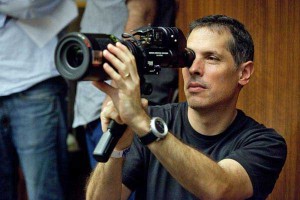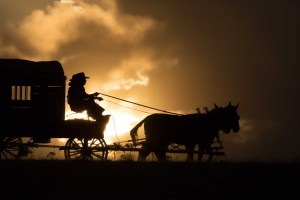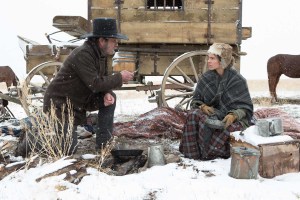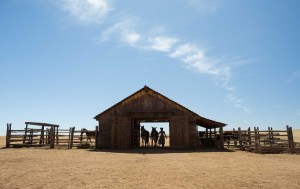
Creating beauty out of bleakness was the challenge for Rodrigo Prieto, the director of photography for The Homesman. The movie – a variation on the traditional Western in that its main character is a strong, self-sufficient woman, played by Hilary Swank – is for the most part set on the flat, dusty edge of the American frontier in the mid-1800s, stretching endlessly against a backdrop of big sky, with only a few simple structures to break the monotony.
Prieto’s approach was to create a geometric aesthetic by emphasizing the strong horizontals of land and sky and the verticals of the simple buildings by artful framing, often through light-filled windows and doors. “It was all about compositions where we had perhaps a small sliver of land and big sky, or a small portion of sky and a big portion of the screen being land,” noted Prieto. Besides using old black-and-white photos for references, Prieto was also influenced by the work of modern minimalist artist-sculpture Donald Judd.

Directed by Tommy Lee Jones, who also co-stars as a mischievous low-life, the plot of Homesman centers on a wagon journey east—not west—across the harsh, but starkly beautiful Nebraska Territories (the film was mainly shot in New Mexico), during the decade before the Civil War. Mary Bee Cuddy, Swank’s pious and stalwart character, has decided to leave her ranch — because no men will — and transport three women who are catatonic from enduring the harshness of pioneer life back to Iowa where a minister and his wife have agreed to take them in. To withstand the dangers of the journey, Cuddy picks up a grifter, played by Jones, for protection.
With a big screen to fill, the DP deftly uses the sky, the ground and the wagon as his main elements—until the travelers head towards the Missouri River and cross over into Iowa, where the scene becomes more civilized and colorful. In the town of Loop where Mary Bee has her homestead, lensing of the low-lit interiors of the sparse structures was enhanced by exteriors viewed through windows and doors. That technique was also used during the wagon journey.
 “It was important to Tommy Lee to use the frame within the frame shot,” said Prieto. “Inside the wagon I shot the door frame and through the window to what’s outside and that became an element of the composition.” The technical challenge was to balance the exposure of the darker interior and the brighter exterior without losing detail. “I didn’t want anyone to feel the footprint of the camera or the lighting—it was all supposed to be authentic and natural.”
“It was important to Tommy Lee to use the frame within the frame shot,” said Prieto. “Inside the wagon I shot the door frame and through the window to what’s outside and that became an element of the composition.” The technical challenge was to balance the exposure of the darker interior and the brighter exterior without losing detail. “I didn’t want anyone to feel the footprint of the camera or the lighting—it was all supposed to be authentic and natural.”
As far as shooting the actors, Prieto made sure to photograph the female characters, especially their faces, the same as he did the men, and not to do anything to beautify the females through lens filtration or special lighting, techniques often accorded to actresses. “All these characters are going through tremendous hardship,” he pointed out. “It was important to me not to differentiate, to avoid being sexist. The film after all has a feminist theme.”
The DP shot Homesman with both a film and a digital camera. He also used both in The Wolf of Wall Street last year for director Martin Scorsese. In the current film, the choice was partly the result of happenstance. He started shooting digitally on an Sony F-55 in prep but Jones liked the grainier look of film, so many of the daytime scenes were shot that way. The digital camera was better in low light situations, especially in several nighttime scenes around a campfire that provided a welcome change of pace to the more austere look that prevails.
 The cinematographer didn’t want the light to fall off from the characters lit by the fire to an absolute black background, so he chose locations for both scenes that were backed either by trees or the wagon itself. He created the effect of a little theater by the fire with bunches of incandescent household light bulbs tucked into the background. “The notion was to put many light bulbs together in different configurations with different flicker patterns, so the light was basically dancing and created shadows that move,” Prieto explained. This was especially effective in the final scene where Jones’ character is dancing a drunken jig on a river barge at night.
The cinematographer didn’t want the light to fall off from the characters lit by the fire to an absolute black background, so he chose locations for both scenes that were backed either by trees or the wagon itself. He created the effect of a little theater by the fire with bunches of incandescent household light bulbs tucked into the background. “The notion was to put many light bulbs together in different configurations with different flicker patterns, so the light was basically dancing and created shadows that move,” Prieto explained. This was especially effective in the final scene where Jones’ character is dancing a drunken jig on a river barge at night.
Prieto, born in Mexico, has worked with many prominent directors on a wide range of ambitious projects. He received an Academy Award nomination for best cinematography for his work on Brokeback Mountain with director Ang Lee. He also worked with Lee on Lust, Caution shot in China. Other directors include Alejandro González Iñárritu (Amores Perros, 21 Grams, Babel, Biutiful), Julie Taymor (Frida), Oliver Stone (Alexander, Wall Street: Money Never Sleeps) and Ben Affleck (Argo). He renews his collaboration with Scorsese on his next film, Silence, about two Jesuits in Japan during the 17th century, which is currently in prep.





